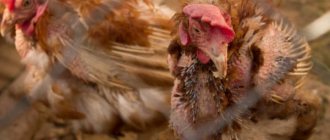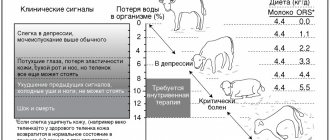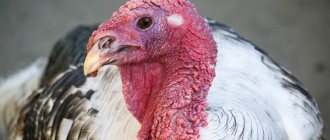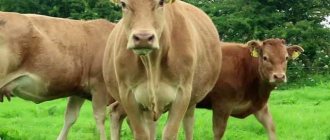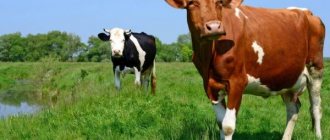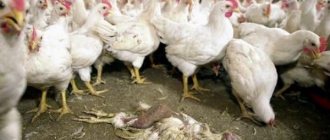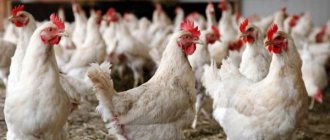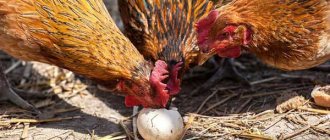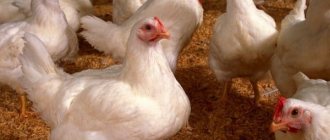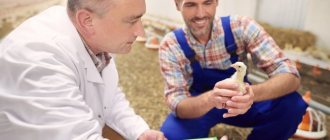Causes
Mastitis in cows can develop due to mechanical, thermal and chemical damage to the udder and teats.
This occurs due to the design of the milking machine when used incorrectly. And also due to violations of sanitary standards, poor conditions, drafts and cold in the barn.
Bruises, microcracks, and wounds on the skin are foci for the development of infection.
Bacteria quickly penetrate the mammary gland through the nipple canal, multiply, and the disease begins to manifest itself.
Fungi and accompanying viruses can complicate the course of the disease. Poor immunity contributes to the development of mastitis.
Poor quality feed can cause mastitis.
When a cow is poisoned, the infection enters the blood and lymph through the gastrointestinal tract. Toxins are carried to all organs, and under unfavorable external conditions the mammary gland becomes inflamed.
Sometimes a pet gets mastitis due to a sudden change in diet, when there is a transition from fresh food to dry food.
Also, sudden cessation of milking after high milk yields leads to this disease. Through dirty bedding, infections can be transmitted from uterine purulent discharge to the nipples.
Dangerous for any livestock
There is not a single country in the world where cows do not suffer from mastitis. People have been aware of this disease from the very moment they began breeding domestic cattle. The disease was first described by French veterinarians in 1884. At all times, dairy cattle farming has suffered massively from this pathology due to deterioration in product quality and considerable costs for therapeutic and preventive measures.
Inflammation of the udder (mastitis) in a cow should be treated with the utmost attention. This is especially true for dairy breeds. The milk of a sick cow is unsuitable for food. But those individuals that are raised for meat production must also have healthy mammary glands, because they will have to feed calves.
Despite the fact that mastitis initially affects only the cow's udder, the disease subsequently leads to intoxication of the entire body. In addition to cattle, other animals and even people suffer from it.
Symptoms
To determine mastitis, the veterinarian must perform udder palpation, control milking and a milk test.
The first signs of mastitis are:
- reduction in milk volume;
- swollen lymph nodes;
- swelling and painful hardening of the udder;
- body temperature increased to 41℃;
- the skin is hyperemic;
- breathing and pulse quicken.
At first, the appearance of the milk does not change, but as the disease progresses, it becomes more watery, bluish, and slimy. Then, flakes and clots begin to appear in the milk.
Subclinical mastitis is determined by a milk test. Its composition reduces the amount of casein and lactose, decreases acidity, but increases the number of chlorides and leukocytes.
Symptoms of mastitis
Mastitis has many forms and manifestations - the course of the disease can be different. But with any type of disease there are the same symptoms:
- The animal is depressed.
- Lost appetite.
- There is swelling on the udder. He has a fever. The udder increases in size - all or only some parts. On palpation there is pain.
- The temperature of the whole body may rise.
- The milk's consistency has changed. It differs in taste and color from the usual one - it often contains blood or pus.
- If you feel the udder, you can determine the presence of knots and seals.
There are forms of mastitis in which the animal’s mammary glands change color - they become spotted.
Attentive ranchers can identify problems early, without waiting for the cow's udder to swell and her temperature to rise. The risk of the disease increases after calving and 1-2 months of pregnancy. The following symptoms may indicate mastitis:
- The nipple turned red. At the beginning of milking, there are traces of flakes or curd balls in the milk.
- Over time, if the disease is not treated, a viscous secretion is observed from the glands.
Diagnostics
The success of treating a cow depends on the timely diagnosis of mastitis.
There are three forms of the disease:
- acute;
- hidden;
- chronic.
In 90% of cases, cows are diagnosed with chronic mastitis. It can be determined by the quality of the milk - it is watery, low-fat and heterogeneous.
Veterinarians diagnose mastitis. Based on clinical data, the specialist determines what type of disease the animal has.
The farmer’s task is to timely monitor the condition of the udder, conduct tests for mastitis, and if it is detected or suspected, contact a veterinarian.
There are many methods for detecting mastitis - testing, various laboratory tests.
Diagnostic procedure:
- Visual inspection of the cow and udder.
- Determining the onset of the disease is when symptoms appeared.
- Determining the cause - what triggered the disease.
- Taking samples and analyses.
To understand the picture of the disease, the veterinarian finds out the living conditions of the animal, its diet and method of milking, and previous diseases.
Before prescribing treatment, the following procedures are performed:
- Milk is being milked - you need to carefully examine the secretion of the udder.
- Temperature, pulse, and breathing rate are measured.
- The lymph nodes in the udder area are examined.
- A comparison is made of the temperature, size and density of different lobes.
- The color of the udder is determined and the integrity of the skin is checked.
- They palpate the nipples for the presence of seals - along the entire length, from the base to the very bottom.
Electronics in dairy service
It is very difficult to identify a subclinical type of disease. You cannot make cheese or cottage cheese from the milk of a sick cow, let alone drink it. You will learn more about this variety by reading the article “Subclinical mastitis in a cow.” And now we will talk about a special test for mastitis, which helps to identify the hidden form. It is done using a special device called “Mastiton”.
Approximately 20 ml of milk is milked from the nipple into a special container on the device. The reference point is complete coverage of the electrodes. Then turn on the device and wait two seconds until the result appears on the display. After recording the readings, rinse the cup and repeat the test for all other nipples.
If the scale shows a result of up to 450 units, then everything is in order - this portion of the udder is healthy and there is no mastitis there. When the readings are higher and reach 600, a hidden infection is possible. If the mark has exceeded 600 units, there is a process of exacerbation.
But know that for complete confidence and accurate diagnosis of mastitis in a cow, the test must be done at least three times. By the way, milk from animals that have suffered from the disease may give questionable results in this analysis until the inflammation goes away completely.
Tests for mastitis
The herder's job is to test for mastitis during high-risk periods:
- beginning of lactation;
- every month after the start of lactation;
- after launch;
- 2 weeks before calving.
If the cow is not examined and treated in time, the previous level of lactation cannot be restored. In difficult cases, the animal dies due to atrophy and gangrene of the mammary gland.
Latent mastitis does not have pronounced symptoms, so special tests are used for its timely diagnosis.
Testing with Mastidine solution
Mastidine allows you to determine the number of leukocytes and pH level.
- Drain the first three streams of milk from each udder lobe.
- Collect 1 ml of milk from each lobe into separate containers. 1 ml of 10% Mastidine solution is dripped into it.
- Mix milk with Mastidine thoroughly using a wooden or glass stick for 20 seconds.
- If the product has acquired a jelly-like consistency, then the cow has udder inflammation.
Testing takes 15 minutes. Disadvantages of Mastidine testing:
- The drug is expensive.
- After opening the bottle, it should be used quickly - it has a short shelf life.
Express testing of udder parts
To examine cows for subclinical mastitis, special control plates are used - they have four recesses with annular grooves. Milk is dripped in there to check.
For testing you can use:
- 5% dimastin solution;
- or 2% mastidine solution.
The color of the hemispherical holes is black and white. The colors are chosen so that it is convenient to diagnose mastitis:
- pus and blood are clearly visible on a white background;
- on black - casein clots and white flakes.
The location of the holes is thought out so that they can be easily numbered in accordance with the shares of the udder.
Settling test
Mastitis can be diagnosed using a sedimentation test. However, it is not considered reliably accurate, so it is used as an additional study.
Test order:
- After milking, 10 ml of milk is siphoned from the nipples. Milk from each nipple is placed in a separate container.
- The milk taken for the test is placed in the refrigerator for 17 hours - a temperature of 10 °C is needed.
- After the expiration date, look at the milk under light. Pay attention to the color, sediment and width of the creamy layer. The result is defined as follows:
- A healthy cow's milk is white. There are no impurities.
- The patient has watery milk. Sediment – from 1 mm.
- If the thickness of the cream is less than 5 mm, the cow has inflammation; if it is more than 1.5 cm, the animal is healthy.
Since the technique is unreliable, it is followed by the testing described above. No more than seven days should pass between checks.
Bromothymol test
Veterinary medicine uses many diagnostic methods. If one test does not show a problem, you need to duplicate it with another test.
There is, for example, a test with Bromthymol:
- Take a 0.5% Bromthymol solution.
- Distilled water or wine alcohol is poured into the indicator.
- Two drops of the resulting mixture are added to 1 ml of milk.
- They observe the color - based on the shade they conclude about the presence of mastitis:
- a healthy cow will have a greenish or yellowish color;
- in cows with hidden inflammation - bright green, yellow or blue.
Testing with Mastiton
The milk of sick cows differs in the ratio of salts - the disease can be detected by measuring electrical conductivity.
Such devices are usually used when examining a large number of cows. Among such devices is Mastiton. The range of readings is from 0 to 1999.
Results of indications and diagnosis:
- Less than 450 – good milk and a healthy cow. The animal does not suffer from mastitis with a probability of 99.9%.
- 450-600 – mastitis may occur.
- More than 600 – the clinical stage develops.
Measurements must be taken many times, preferably daily. If the device shows more than 600 units, you need to carry out an additional test - for example, using Mastidine.
The disadvantage of the Mastiton device is its large error, it is more than 30%!
Tips for diagnosis using Mastiton:
- Test milk from all shares. This is especially true for older cows who have had other diseases. If, for example, the device shows 450 in 3 parts, and 600 in one part, the risk of developing the disease is extremely high.
- The risk group includes cows that have had inflammation of the mammary gland. Their indicator is above 500. But this result is the consequences of an illness.
- If in a large herd the device shows more than 500, it is necessary to check the milking machines - the milking technique may be impaired.
Symptoms and diagnosis
The presence of mastitis is usually indicated by a decrease in milk production and anxiety of the animal during milking. Hand milking or cup placement will cause the cow to experience pain. According to clinical and diagnostic indicators, mastitis is divided into several types.
Subclinical mastitis
The most common type of udder inflammation, on large farms it can reach over 50%, and sometimes the disease is registered in the entire livestock. The main disadvantage is that there are no symptoms of hidden mastitis, the only thing is that there may be an enlargement of the supraglavicular lymph nodes, but this is difficult for a non-specialist to identify. Therefore, at home, subclinical mastitis in cows is rarely recorded and is detected on dairy farms during routine diagnostics using milk samples from each lobe of the udder; for this, a special reagent is used, for example, “Kenotest”. Also, latent mastitis is detected by bacteriological examination of milk.
Serous inflammation of the udder
This form usually develops after injury or milking disturbance, less often when exposed to microbes. Clinically, serous mastitis in cows manifests itself:
- increase in the affected quarter;
- local temperature rise;
- the skin of the udder is swollen and tense;
- breast hyperemia;
- palpation reveals pain;
- the suprauterine nodes are enlarged;
- Usually one of the lobes is affected, less often the right or left halves; mastitis in a cow of all lobes is rare;
- general decrease in milk productivity;
- the quality of milk deteriorates in the later stages of the disease;
- General fatigue and loss of appetite may appear.
Catarrhal mastitis
Manifests itself in the form of inflammation of the mammary ducts or alveoli of the mammary gland. It often develops due to mechanical trauma to the nipples, followed by contamination with pathogenic agents and ascending inflammation. Catarrhal mastitis has the following symptoms:
- the first streams of milk delivered are liquid;
- the sediment contains flakes and clots;
- when the milk ducts are affected, the nipple becomes clogged with cheesy exudate;
- thickening of the nipple, fluctuation is noted at its base;
- damage to the alveoli is characterized by the presence of dense nodes in the udder, tuberosity is often noted;
- milk contains flakes and often breaks up into fractions;
- udder soreness is not expressed;
- local temperature rarely rises;
- the general condition usually does not change.
Fibrinous inflammation of the mammary gland
There are two ways of development: a complication of catarrhal mastitis, or as a transition of an infectious agent with endometritis, purulent pericarditis. The main difference from other forms is fibrin effusion; blood is less often found in milk. Symptoms:
- a sharp decrease and complete cessation of milk production;
- from the nipple you can get a few drops of exudate mixed with fibrin;
- fibrin differs from other exudates by crepitus when rubbed between the fingers;
- the affected lobe is enlarged, palpation causes pain;
- local and general temperature is increased;
- lymph nodes are enlarged.
Purulent form, abscesses and phlegmon of the udder
It also develops from mucous mastitis in the absence of treatment and the obligatory presence of microbes, usually streptococci. Signs of purulent inflammation:
- milk production decreases sharply;
- the extract from the affected lobe is minimal, the milk has a bitter taste;
- presence of clots, reddish tint;
- the udder is hot;
- skin hyperemia is pronounced;
- swelling of the skin, pain during milking;
- the overall temperature rises to 410C;
- the pathological process resolves on its own either by the proliferation of connective tissue or by an udder abscess;
- in this case, the udder is tuberous;
- the temperature is elevated;
- cereal in milk;
- when mature, the abscess bursts; if it was under the skin, then the fistula canal is visible. A fistula into the udder tank is also possible, in which case a lot of pus will be found during milking;
- The most dangerous form of udder phlegmon is diffuse inflammation against the background of postpartum edema.
There are also specific forms of udder inflammation in cows caused by dangerous infectious diseases:
- hemorrhagic mastitis becomes a sign of a general decline in resistance and the presence of a septic process;
- inflammation of the mammary gland during foot and mouth disease is characterized by blisters - aphthae on the skin of the udder;
- actinomycosis of the udder. It differs from an abscess by a powerful hard capsule of connective tissue, and there is no enlargement of the lymph nodes;
- tuberculosis, contrasting nodules are noted on the X-ray photo.
Varieties
For treatment to be successful, it is important not only to identify mastitis on time, but also to correctly determine its type. This can be done based on symptoms and test results.
Clinical
In the clinical form of mastitis, the udder hardens and swells, and it becomes hot at the site of the lesion.
Symptoms depend on the severity of the disease:
- with a mild form - there are flakes and lumps in the milk;
- with a moderate form - the udder swells, hardens, turns red and becomes painful;
- in severe cases – intoxication, the animal’s condition is critical.
Subclinical
This form of the disease is dangerous because it occurs latently. It remains asymptomatic for a long time. It can be determined through laboratory tests - by counting somatic cells and analyzing microflora.
If subclinical mastitis is not detected in time, it will develop into a clinical form.
Chronic
As with subclinical mastitis, the form of the disease is hidden. You may not suspect for a long time that your cow is sick. The bacteria that cause the disease are found in tissues.
The chronic form occurs if the cow’s body overcomes short-term inflammation and an imaginary recovery occurs.
To diagnose chronic mastitis, use: visual assessment of milk - it is watery, with fragments of flakes; tests; by settling method.
If the animal does not receive adequate treatment, the disease will periodically worsen.
Catarrhal
Catarrhal mastitis
It usually occurs due to improper milking. Most often, only one lobe of the udder is affected. The infection, penetrating the tissues, affects the milk ducts and mucous membranes.
The route of entry for bacteria is the nipple.
External symptoms:
- small nodules near the nipple - they appear on the 5th day of illness;
- in the first days the animal feels normal, then a high temperature appears;
- the cow eats poorly and becomes weaker;
- the milk becomes low-fat and contains flakes.
Purulent
Symptoms of the purulent form:
- Hardenings appear on the animal's udder.
- The temperature at the compaction site rises.
- Body temperature is very high – 40-41 degrees.
- Milk contains pus.
With purulent inflammation of the udder, the following may also occur:
- Abscess. Abscesses appear on the mammary gland, growing and merging with each other. The cow has a high temperature. The disease leads to destructive changes - part of the gland does not function. With reduced immunity, metastases begin.
- Phlegmon. With this purulent form, a diffuse focus of pus appears. Milk expressed from the diseased lobe is gray and contains a lot of clots.
Fibrinous
Fibrinous mastitis develops from catarrhal or occurs independently by hematogenous-embolic route, more often with purulent endometritis, traumatic cervicitis, purulent pericarditis.
A characteristic feature of this form of mastitis is the exudation of fibrin onto the surface of the mucous membrane or its deposition in the thickness of the tissue. In cows, purulent-fibrinous inflammation of the udder is more often observed.
Milk secretion sharply decreases or stops. At first, the milk may be slightly changed, but already on the 2-3rd day, a few drops of serum or purulent exudate mixed with fibrinous crumbs are hardly squeezed out of the nipple.
When fibrinous inflammation has developed from catarrhal inflammation, crumbly yellow clumps are added to the flakes characteristic of the latter in the milk; the milk takes on the appearance of pus.
Purulent-catarrhal
If pus accumulates in the alveoli and milk ducts, purulent mastitis turns into purulent catarrhal. It occurs as a result of the activity of pyogenic bacteria.
Cause of the disease:
- poor conditions of detention;
- problems in the reproductive system.
After 3-4 days from the onset of the disease, visible symptoms of the disease disappear. This form of mastitis either goes away or becomes chronic.
Serous and acute serous
Serous form of mastitis
Appears after calving. Only part of the udder becomes inflamed.
Symptoms:
- swelling and redness of the udder;
- compaction and increase in temperature of the inflamed area;
- The milk is liquid, with flakes, more like water.
In the serous form of the disease, the milk becomes bluish.
Fibrous
This form occurs most often as a consequence of catarrhal mastitis.
Symptoms:
- hemorrhages are visible in the affected tissues;
- discharge of pus.
Fibrous mastitis often ends in gangrene or metastases to other organs. The prognosis is unfavorable.
In the fibrotic form, fibrin protein enters the tissues, accumulates in them, this causes poor circulation and even necrosis.
Hemorrhagic
Accompanied by thinning of the walls of the mammary gland vessels. Blood, seeping into the tissues and milk ducts, clogs them.
Characteristic symptoms:
- milk has a reddish or pinkish tint;
- There are purple spots on the skin of the udder.
Gangrenous
This is the most severe case of mastitis. Its development is preceded by a circulatory disorder.
Symptoms:
- the tissues of the affected lobes become dead, blue-black in color;
- a foul-smelling liquid is released from the udder - brown or green, with protein flakes.
The worst prognosis. The animal may die if the infection spreads to other vital organs.
Irreversible processes
The severity of the disease makes it possible to divide the types of mastitis in a cow according to the nature of the disease. If a cow has a sharp rise in temperature, swelling of the udder is clearly visible, sunken eyes, increased fever, rapid and weak pulse, then this is a hyperacute form.
In a moderately acute course, the diagnostic signs are the same, but they are much less pronounced. You can be sure of pathology if yellow flakes appear in the milk. In both forms, all of the above phenomena are observed within two weeks.
During subacute mastitis, systemic signs of udder swelling and disruption of secretions in the glands are not very pronounced. And in chronic cases, it is even more difficult to determine mastitis. For several months a cow may be in a semi-sick state, without receiving any help. As a result of prolonged inflammation after recovery, the affected portion of the udder can completely atrophy. For the owner, a signal for an urgent examination may be the resulting wateriness of the milk received and the presence of flakes in it.
Treatment
A cow diagnosed with mastitis should be separated from the herd. If the herd is on the range, then the sick animal is not allowed to pasture - it is left in the barn.
What to do first:
- Give the cow less juicy and roughage food and less drink to reduce milk production.
- Change the straw litter twice a day - this will prevent the spread of germs.
- Express milk 6 times a day, at least 4 times. Inexperienced cattle breeders think that if a cow’s udder hurts, they don’t need to milk it. However, milking promotes the release of microorganisms along with the milked milk. Milking helps relieve swelling.
- Procedures are performed only with disposable instruments to prevent re-infection.
Drug treatment
Drug treatment requires financial costs, but in many cases, this is the only way to help the animal.
For mastitis they usually use:
- The hormonal drug is oxytocin. To speed up recovery. The use of this drug is dangerous for pregnant cows - it can provoke calving ahead of schedule. The medicine is administered subcutaneously - 5 units per 100 kg of weight. Before injecting the hormone, milk is milked and then oxytocin is injected into the jugular vein.
- Antibiotics. Before injecting antibiotics, it is important to recognize the type of infection that caused the inflammation - this is done by examining the microflora in the laboratory. Only specialists can choose the right medications, but the owner himself can administer them to the animal.
Methods of administering antibiotics:
- Intramuscular injections. At the onset of general intoxication, potent drugs are used - Bicilin-5 or Nitox.
- Penersin, Masticide, Mastisan are administered through the catheter The drugs must be administered over 3-4 days.
- Intrammary injections - the substance is injected directly into the udder. The medicine is sold in syringes - “Mastisan” or “Gamaret”. Before the injection, the udder is completely freed from milk.
- The drug is administered during a novocaine blockade placed above the udder. This method requires special skills.
After using antibiotics, milk is inedible for another 5 days after the end of treatment.
For mastitis, antibiotics can also be prescribed after identifying a pathogenic bacterium:
- Benstrep - sold in glass bottles. Affects gram-positive bacteria.
- Maximaks - sold in dispensing syringes. Affects staphylococci, streptococci, pathogenic anaerobes, etc.
- Penmicin - destroys gram-positive and gram-negative bacteria. Does not affect viruses and fungi.
- Doreen - affects microbes that multiply in the udder exudate.
- Penicillin.
- Erythromycin.
- Monomycin.
- Neomycin and others.
Solutions must be warmed to the cow's body temperature before administration. 80 ml is enough for one injection.
If the case is advanced, the cow is prescribed a combination of drugs. For example, a good combination is given by the combinations:
- penicillin and streptomycin;
- streptomycin and erythromycin;
- neomycin and tetracycline.
If the cow has a chronic purulent form, antibiotics may not help. If parenchymal atrophy occurs, the milk ducts are not restored; on the contrary, the infection spreads further and further.
In the video, experts talk about the treatment of mastitis with non-steroidal anti-inflammatory drugs:
Complex treatment
Mastitis not only changes the cow's udder, it affects the general condition of the body. Therefore, a sick animal must receive comprehensive treatment.
Antibiotics alone are not enough to treat mastitis - you need to not only kill the infection, but also restore the cow’s immunity.
If the animal has an acute form of the disease, along with antibiotics the following is used:
- liquid solution of streptocide - intravenously;
- inside the udder - 1% solution of streptocide or 2.5% solution of ichthyol.
If a cow has a severe form of the disease, antibiotics are supplemented with:
- 40% glucose solution;
- 10% calcium chloride/gluconate solution (100-150 ml);
- 0.25% solution of novocaine (0.5-1 ml per 1 kg of weight).
In parallel, the following procedures are performed on the animal:
- applications with valeter or anixide;
- application of camphor or ichthyol ointments;
- warming with paraffin or ozokerite – on days 3-5;
- heating with an infrared lamp.
In particularly difficult conditions - with purulent inflammation, abscess, gangrene, phlegmon, it is recommended to additionally administer to the animal:
- Glucose 40% – 400 ml.
- Calcium chloride or gluconate solution – up to 150 ml.
- Saline solution with novocaine – 1 ml per 1 kg of weight.
- Hexamine with calcium chloride – 10 ml.
- Calcium permanganate solution 1% - for gangrene, injected directly into the nipple of the diseased lobe.
- Caffeine - to maintain the body.
When abscesses and ulcers appear, they must be opened. The operation should be trusted only to a specialist. Opened abscesses require care like open wounds.
The video talks about the most popular and effective medications for mastitis. Express review of ointments, sprays and creams:
Massage
For mastitis, the animal is recommended to massage the udder and nipples. Before milking, the udder is wiped with warm water, and then they begin to gently and smoothly massage each nipple in turn.
The movements should seem to push the nipples upward.
Please note:
- For the serous and fibrous form, if there is no pain yet, massage is performed twice a day. The massage should start from the bottom.
- With catarrhal massaging, on the contrary, starts from the top.
- For hemorrhagic mastitis, massage is contraindicated.
Traditional methods
Mastitis is a serious disease that requires testing and supervision by a veterinarian. It is not recommended to limit yourself to so-called “traditional” methods of treatment.
Lack of adequate medical care can be fatal for the animal. Traditional methods can only serve as an addition to treatment.
What is done to alleviate the condition of a cow with mastitis:
- make vodka compresses;
- add grated carrots, coltsfoot leaves, cabbage leaves, bean flour;
- apply compressors with rice starch - it must be diluted with boiled water to the consistency of sour cream;
- lubricate the udder with an ointment made from a mixture of starch and vegetable oil;
- make compresses from milk, rye flour and butter;
- apply kombucha;
- apply a mixture of milk and baked onions;
- add finely chopped daffodil bulbs.
For mastitis, heating and hot compresses are prohibited - elevated temperatures promote the proliferation of microbes.
Experienced cattle breeders also recommend combating seals with eucalyptus ointment. You will need:
- eucalyptus leaves;
- soap grass;
- Japanese acacia.
Take 4 tablespoons of each ingredient. Pour boiling water (1 cup) over the mixture and boil for 5 minutes. After insisting and straining the broth, add 100 g of butter. Lubricate the udder with the prepared ointment.
Compresses help relieve inflammation and reduce pain. Given the complexity of the disease, it is unlikely that compresses will help an animal that has, for example, purulent mastitis.
Traditional methods are only an addition to the treatment of inflammation.
Inadequate treatment can lead to the following consequences:
- the disease becomes chronic or latent;
- part of the udder is lost;
- in the worst case, the animal dies.
Research before and after the death of a cow
To accurately diagnose an infection and determine its type, bacteriological tests are performed. They study the secrets of the udder and milk. Epizootological studies help identify the specific type of pathogen. Only after accurate tests is a veterinarian able to prescribe effective treatment. We give some advice on this topic in the article “Mastitis in cows: symptoms and treatment.”
If the cow cannot be saved, its organs are examined and examined by pathologists through necropsy. Usually, enlarged lymph nodes are found, on which hemorrhages are clearly visible. The same indicators are characteristic of the lungs; they usually look swollen. As a rule, all alveoli are filled with secretions that are secreted by the cells of the body.
During pathological studies, certain phenomena characteristic of a particular type of mastitis are observed. So, for example, if a cow was sick with a purulent form, then abscesses and purulent-necrotic inflammation will be evident in the udder. And if it was a streptococcal infection, then the udder will atrophy.
You have learned the difference and how mastitis in cows is classified, share this information with your friends on social networks.
If the article was useful to you, please like it.
Prevention measures
To prevent cows from getting mastitis, you must follow the rules of their maintenance and milking techniques.
Prevention of mastitis includes the following measures:
- Animals must be kept in clean and warm premises.
- Only specialists should work with cows. This is especially true in milking parlors.
- Cows should receive high-quality and nutritious feed.
- Animals must be under the supervision of an experienced veterinarian.
- You need to monitor the condition of the udder - respond in time to cuts, wounds, cracks.
- Extreme caution is required by the machine milking operator if automated milking is used. Rough or inept movements can cause illness.
- Milking should be carried out regularly - at regular intervals.
- Before and after milking, it is imperative to massage the udder.
What is mastitis in a cow?
One of the most common diseases in dairy farming is mastitis. Appears against the background of some complications after childbirth, which are supplemented by problematic care and feeding. Disorders affect the udder at the level of glandular tissue.
General symptoms are presented:
- health problems;
- decreased productivity levels;
- elevated temperature;
- the appearance of foreign clots in the product;
- pain and anxiety during manual milking.
Did you know? Cows have a well-developed sense of time: for example, a milkmaid being half an hour late reduces milk yield by 5% and the fat content of the product by 0.4%.
Preventive measures
Treatment of mastitis is a significant cost for the farm. It is more advisable to maintain high-quality conditions for keeping the animal than to spend money on emergency veterinary care or purchasing a new animal. Therefore, it should be noted that prevention is the best measure to prevent the development of mastitis in cows.
Preventive measures aimed at preventing the manifestation of mastitis in cows should include:
- selection of qualified personnel to work with animals;
- organizing and maintaining high-quality conditions for keeping cows in accordance with sanitary standards;
- strict adherence to the regimes and norms of feeding and drinking regime of animals;
- organization and strict adherence to the rules and regimes of milking;
- keeping the barn and surrounding areas clean;
- providing veterinary care to cows;
- identification, treatment and implementation of preventive measures for diseases of the gastrointestinal tract and reproductive system of animals;
- carrying out measures related to the prevention, timely detection and treatment of edema of the mammary gland of cows during the post-calving and colostrum period;
- following the rules and standards of personal hygiene when working with animals.
To summarize, it should be said that mastitis in cows is easier and more important to prevent than to detect and treat. But even if, for reasons beyond the owner’s control, the animal still gets sick, you should not give up, since there are reliable drugs for the treatment and prevention of mastitis in cows, which provide a 100% guarantee of the animal’s recovery.
Massages and decoctions
Despite the seriousness of the disease, mastitis can be cured at home. It is important to identify it as early as possible and begin providing assistance to the cow in a timely manner. Caring for an animal during illness becomes very thorough and requires compliance with hygiene standards with particular rigor.
Before you begin to treat mastitis in a cow, it must be placed in a separate room. This rule must be followed both in a large farm with thousands of “heads” of livestock, and in the event that you only have a few animals in one stall at home.
To wash the udder, prepare a warm saline solution. About a tablespoon of salt per 3-5 liters of water. A decoction of fresh nettle is used for the same purpose. After expressing milk, massage each nipple and lobe of the udder. Particular emphasis is placed on the place where there is compaction. Movements are directed from top to bottom, as when milking. The hands seem to push the stagnant formations inside to exit through the nipple.
Different ways
In the treatment of catarrhal and fibrous mastitis, clay applications on the udder of a cow, decoctions of plantain and yarrow for ablution are helpful. No massage needed. Compresses with clay are usually made at night, carefully wrapping the coated udder with oilcloth and warm cloth, creating insulation. This somewhat relieves swelling and numbs the sore spot. And in the morning, the mammary glands are washed with decoctions of herbs with an antibacterial effect.
The hemorrhagic form requires frequent milking and massages with camphor. It is advisable to perform all rubbing of the udder with any ointment after the inflammation has subsided. Also, before the massage, the cow needs to loosen her stomach. You can use Carlsbad salt in the following dosage: 2 tablespoons of salt per liter of water. A decoction of bear ears is used as a laxative.
Folk remedies also help to relieve the symptoms of cow mastitis. Basically, these are various warm-ups. For example, heated paraffin, which is applied to the udder in several layers. The oilcloth attached on top will retain heat for a long time.
Compresses made from aloe juice and heating with a quartz lamp are also common.
Lethal means
Treatment of mastitis in cows with antibiotics remains the main remedy used by veterinarians in severe advanced cases. At the same time, do not forget that in nutrition during illness, preference is given to dry food, that is, not fresh grass, but hay. And another very important point. If you have always used the machine milking method, now you should express milk only by hand and at least three times a day.
When an animal's body temperature rises, treatment for mastitis, both in cows and in any cattle, begins with antibiotics. For an intramuscular course, the drug “Bicillin-5” is suitable. Another method of administration is directly into the udder. In this case, they use Mastisan, which is sold in veterinary pharmacies immediately in a tube, ready for use. Be sure to express all your milk before giving the injection.
They conscientiously fight against microbes “Drin”, “Penmicin”, “Benstrep”. Each of the drugs is used for a specific form of mastitis and can only be prescribed by a doctor, who determines the dosage and frequency of injections based on the weight of the cow.
Symptoms of the disease
Early manifestations of mastitis in a cow have the appearance of an unmilked udder, characterized by excessive density, elasticity and increased temperature. At first, the clinical picture is blurry: symptoms may appear and disappear periodically. As the disease progresses, the symptoms become more pronounced, and small clots can be detected in milk when boiled. At the same time, the animal becomes lethargic, general tone and appetite decrease.
Latent mastitis in cows is manifested by compactions in the udder, which are revealed by palpation, while no clots are found in the milk.
The acute course of the disease leads to the death of the animal. This is due to the fact that the inflammatory process can move from the udder to neighboring tissues, first forming an abscess, and then udder gangrene, which in more than 90% of cases leads to death.
The most common chronic form of mastitis in cows. The milk of such an animal becomes watery, flakes are visualized in it, and the fat content decreases.
How to milk a cow after mastitis
To properly milk a cow after mastitis, you should repeat the milking procedure 5-6 times a day. For active milk production, a course of the hormone oxytocin is administered, which significantly increases milk production. The drug can also be used in case of complete loss of milk after calving. The cow must be milked gradually, alternately checking lactation in the diseased and healthy lobes.
Important! You should change your diet: add more succulent food and vitamins. Also during this period the cow should drink enough fluid.
